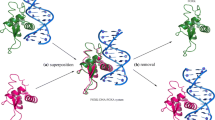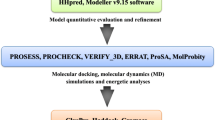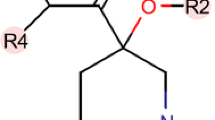Abstract
Overexpression of Forkhead box protein C2 (FOXC2) has been associated with different types of carcinomas. FOXC2 plays an important role in the initiation and maintenance of the epithelial–mesenchymal transition (EMT) process, which is essential for the development of higher-grade tumors with an enhanced ability for metastasis. Thus, FOXC2 has become a therapeutic target for the development of anticancer drugs. MC-1-F2, the only identified experimental inhibitor of FOXC2, interacts with the full length of FOXC2. However, only the DNA-binding domain (DBD) of FOXC2 has resolved crystal structure. In this work, a three-dimensional (3D) structure of the full-length FOXC2 using homology modeling was developed and used for structure-based drug design (SBDD). The quality of this 3D model of the full-length FOXC2 was evaluated using MolProbity, ERRAT, and ProSA modules. Molecular dynamics (MD) simulation was also carried out to verify its stability. Ligand-based drug design (LBDD) was carried out to identify similar analogues for MC-1-F2 against 15 million compounds from ChEMBL and ZINC databases. 792 molecules were retrieved from this similarity search. De novo SBDD was performed against the full-length 3D structure of FOXC2 through homology modeling to identify novel inhibitors. The combination of LBDD and SBDD helped in gaining a better insight into the binding of MC-1-F2 and its analogues against the full length of the FOXC2. The binding free energy of the top hits was further investigated using MD simulations and MM/GBSA calculations to result in eight promising hits as lead compounds targeting FOXC2.
Graphical abstract













Similar content being viewed by others
References
Kalluri R, Neilson EG et al (2003) Epithelial–mesenchymal transition and its implications for fibrosis. J Clin Invest 112:1776–1784. https://doi.org/10.1172/JCI20530
Kalluri R, Weinberg RA et al (2009) The basics of epithelial–mesenchymal transition. J Clin Invest 119:1420–1428. https://doi.org/10.1172/JCI39104
Tsai JH, Yang J (2013) Epithelial–mesenchymal plasticity in carcinoma metastasis. Genes Dev 27:2192–2206. https://doi.org/10.1101/gad.225334.113
Mitra A, Mishra L, Li S (2015) EMT, CTCs and CSCs in tumor relapse and drug-resistance. Oncotarget 6:10697–10711. https://doi.org/10.18632/oncotarget.4037
Sato R, Semba T, Saya H, Arima Y (2016) Concise review: stem cells and epithelial–mesenchymal transition in cancer: biological implications and therapeutic targets. Stem Cells 34:1997–2007. https://doi.org/10.1002/stem.2406
Shi Y, Massagué J (2003) Mechanisms of TGF-β signaling from cell membrane to the nucleus. Cell 113:685–700. https://doi.org/10.1016/S0092-8674(03)00432-X
Medici D, Hay ED, Olsen BR (2008) Snail and Slug promote epithelial-mesenchymal transition through β-catenin–T-cell factor-4-dependent expression of transforming growth factor-β3. Mol Biol Cell 19:4875–4887. https://doi.org/10.1074/jbc.M111.276311
Niessen K, Fu Y, Chang L, Hoodless PA, McFadden D, Karsan A (2008) Slug is a direct Notch target required for initiation of cardiac cushion cellularization. J Cell Biol 182:315–325. https://doi.org/10.1083/jcb.200710067
Mani SA, Yang J, Brooks M, Weinberg RA (2007) Mesenchyme Forkhead 1 (FOXC2) plays a key role in metastasis and is associated with aggressive basal-like breast cancers. Proc Natl Acad Sci USA 104:10069–10074. https://doi.org/10.1073/pnas.0703900104
Chen X et al (2019) Structural basis for DNA recognition by FOXC2. Nucleic Acids Res 47:3752–3764. https://doi.org/10.1093/nar/gkz077
Golson ML, Kaestner KH (2016) Fox transcription factors: from development to disease. Development 143:4558–4570. https://doi.org/10.1242/dev.112672
Clark KL, Halay ED, Lai E, Burley SK (1993) Co-crystal structure of the HNF-3/fork head DNA-recognition motif resembles histone H5. Nature 364:412–420. https://doi.org/10.1038/364412a0
Brent MM, Anand R, Marmorstein R (2008) Structural basis for DNA recognition by FoxO1 and its regulation by posttranslational modification. Structure 16:1407–1416. https://doi.org/10.1016/j.bbamcr.2010.11.025
Boura E, Rezabkova L, Brynda J, Obsilova V, Obsil T (2010) Structure of the human FOXO4-DBD–DNA complex at 1.9 Å resolution reveals new details of FOXO binding to the DNA. Acta Crystallogr D Biol Crystallogr 66:1351–1357. https://doi.org/10.1107/s0907444910042228
Littler DR, Alvarez-Fernández M, Stein A, Hibbert RG, Heidebrecht T, Aloy P, Medema RH, Perrakis A (2010) Structure of the FoxM1 DNA-recognition domain bound to a promoter sequence. Nucleic Acids Res 38:4527–4538. https://doi.org/10.1093/nar/gkq194
Singh P, Han EH, Endrizzi JA, O’Brien RM, Chi Y-I (2017) Crystal structures reveal a new and novel FoxO1 binding site within the human glucose-6-phosphatase catalytic subunit 1 gene promoter. J Struct Biol 198:54–64. https://doi.org/10.1016/j.jsb.2017.02.006
Fang J, Dagenais SL, Erickson RP, Arlt MF, Glynn MW, Gorski JL, Seaver LH, Glover TW (2000) Mutations in FOXC2 (MFH-1), a forkhead family transcription factor, are responsible for the hereditary lymphedema-distichiasis syndrome. Am J Hum Genet 67:1382–1388. https://doi.org/10.1086/316915
Bell R, Brice G, Child A, Murday V, Mansour S, Sandy C, Collin J, Brady A, Callen D, Burnand K, Mortimer P, Jeffery S (2001) Analysis of lymphoedema-distichiasis families for FOXC2 mutations reveals small insertions and deletions throughout the gene. Hum Genet 108:546–551. https://doi.org/10.1007/s004390100528
Yu M et al (2013) Circulating breast tumor cells exhibit dynamic changes in epithelial and mesenchymal composition. Science 339:580–584. https://doi.org/10.1126/science.1228522
Wang T, Zheng L, Wang Q, Hu Y-W (2018) Emerging roles and mechanisms of FOXC2 in cancer. Clin Chim Acta 479:84–93. https://doi.org/10.1186/s12935-020-01265-0
Xia L et al (2013) Overexpression of forkhead box C1 promotes tumor metastasis and indicates poor prognosis in hepatocellular carcinoma. Hepatology 57:610–624. https://doi.org/10.1002/hep.26029
Hollier BG et al (2013) FOXC2 expression links epithelial-mesenchymal transition and stem cell properties in breast cancer. Cancer Res 73:1981–1992. https://doi.org/10.1158/0008-5472.CAN-12-2962
Werden SJ et al (2016) Phosphorylation of serine 367 of FOXC2 by p38 regulates ZEB1 and breast cancer metastasis, without impacting primary tumor growth. Oncogene 35:5977–5988. https://doi.org/10.1038/onc.2016.203
Yu YH et al (2013) MiR-520h-mediated FOXC2 regulation is critical for inhibition of lung cancer progression by resveratrol. Oncogene 32:431–443. https://doi.org/10.1038/onc.2012.74
Castaneda M, Chen L, Pradhan L, Li S, Zein R (2018) A Forkhead box protein C2 inhibitor: targeting epithelial–mesenchymal transition and cancer metastasis. ChemBioChem 19:1359–1364. https://doi.org/10.1002/cbic.201800022
Awale M, Reymond J-L (2014) A multi-fingerprint browser for the ZINC database. Nucleic Acids Res 42:W234–W239. https://doi.org/10.1093/nar/gku379
Irwin JJ, Sterling T, Mysinger MM, Bolstad ES, Coleman RG (2012) ZINC: a free tool to discover chemistry for biology. J Chem Inf Model 52:1757–1768. https://doi.org/10.1021/ci3001277
Rogers D, Hahn M (2010) Extended-connectivity fingerprints. J Chem Inf Model 50:742–754. https://doi.org/10.1021/ci100050t
Hagadone TR (1992) Molecular substructure similarity searching: efficient retrieval in two-dimensional structure databases. J Chem Inf Comput Sci 32:515–521. https://doi.org/10.1021/ci00009a019
Davies M, Nowotka M, Papadatos G, Dedman N, Gaulton A, Atkinson F, Bellis L, Overington JP (2015) ChEMBL web services: streamlining access to drug discovery data and utilities. Nucleic Acids Res 43:W612–W620. https://doi.org/10.1093/nar/gkv352
Berthold MR, Cebron N, Dill F, Gabriel TR, Kötter T, Meinl T, Ohl P, Thiel K, Wiswedel B (2009) KNIME—the Konstanz information miner: version 2.0 and beyond. ACM SIGKDD Explor Newsl 11:26–31. https://doi.org/10.1145/1656274.1656280
Borgelt C, Meinl T (2009) Full perfect extension pruning for frequent subgraph mining. In: Zighed DA, Tsumoto S, Ras ZW, Hacid H (eds) Mining complex data, vol 165. Studies in computational intelligence. Springer, Berlin, pp 189–205. https://doi.org/10.1007/978-3-540-88067-7_11
Yang J, Yan R, Roy A, Xu D, Poisson J, Zhang Y (2015) The I-TASSER Suite: protein structure and function prediction. Nat Methods 12:7–8. https://doi.org/10.1038/nmeth.3213
Zhang Y, Kolinski A, Skolnick J (2003) TOUCHSTONE II: a new approach to ab initio protein structure prediction. Biophys J 85:1145–1164. https://doi.org/10.1016/S0006-3495(03)74551-2
Zhang Y, Kihara D, Skolnick J (2002) Local energy landscape flattening: parallel hyperbolic Monte Carlo sampling of protein folding. Proteins Struct Funct Bioinform 48:192–201. https://doi.org/10.1002/prot.10141
Benkert P, Biasini M, Schwede T (2011) Toward the estimation of the absolute quality of individual protein structure models. Bioinformatics 27:343–350. https://doi.org/10.1093/bioinformatics/btq662
Williams CJ et al (2018) MolProbity: more and better reference data for improved all-atom structure validation. Protein Sci 27:293–315. https://doi.org/10.1002/pro.3330
Colovos C, Yeates TO (1993) Verification of protein structures: patterns of nonbonded atomic interactions. Protein Sci 2:1511–1519. https://doi.org/10.1002/pro.5560020916
Sippl MJ (1993) Recognition of errors in three-dimensional structures of proteins. Proteins Struct Funct Bioinform 17:355–362. https://doi.org/10.1002/prot.340170404
Wiederstein M, Sippl MJ (2007) ProSA-web: Interactive web service for the recognition of errors in three-dimensional structures of proteins. Nucleic Acids Res 35:W407–W410. https://doi.org/10.1093/nar/gkm290
Brooks BR et al (2009) CHARMM: the biomolecular simulation program. J Comput Chem 30:1545–1614. https://doi.org/10.1002/jcc.21287
Jorgensen WL, Chandrasekhar J, Madura JD, Impey RW, Klein ML (1983) Comparison of simple potential functions for simulating liquid water. J Chem Phys 79:926–935. https://doi.org/10.1063/1.445869
Eastman P, Pande V (2010) OpenMM: A hardware-independent framework for molecular simulations. Comput Sci Eng 12:34–39. https://doi.org/10.1109/MCSE.2010.27
Essmann U, Perera L, Berkowitz ML, Darden T, Lee H, Pedersen LG (1995) A smooth particle mesh Ewald method. J Chem Phys 103:8577–8593. https://doi.org/10.1063/1.470117
McGibbon RT et al (2015) MDTraj: a modern open library for the analysis of molecular dynamics trajectories. Biophys J 109:1528–1532. https://doi.org/10.1016/j.bpj.2015.08.015
McGann M (2012) FRED pose prediction and virtual screening accuracy. J Chem Inf Model 51:578–596. https://doi.org/10.1021/ci100436p
McGann M (2012) FRED and HYBRID docking performance on standardized datasets. J Comput Aided Mol Des 26:897–906. https://doi.org/10.1007/s10822-012-9584-8
Kelley BP, Brown SP, Warren GL, Muchmore SW (2015) POSIT: flexible shape-guided docking for pose prediction. J Chem Inf Model 55:1771–1780. https://doi.org/10.1021/acs.jcim.5b00142
Zhang Y (2008) I-TASSER server for protein 3D structure prediction. BMC Bioinform 9:1–8. https://doi.org/10.1186/1471-2105-9-40
Roy A, Kucukural A, Zhang Y (2010) I-TASSER: a unified platform for automated protein structure and function prediction. Nat Protoc 5:725–738. https://doi.org/10.1038/nprot.2010.5
Koes DR, Baumgartner MP, Camacho CJ (2013) Lessons learned in empirical scoring with smina from the CSAR 2011 benchmarking exercise. J Chem Inf Model 53:1893–1904. https://doi.org/10.1021/ci300604z
Jiménez J, Skalic M, Martinez-Rosell G, de Fabritiis G (2018) K deep: protein–ligand absolute binding affinity prediction via 3d-convolutional neural networks. J Chem Inf Model 58:287–296. https://doi.org/10.1021/acs.jcim.7b00650
Mysinger MM, Carchia M, Irwin JJ, Shoichet BK (2012) Directory of useful decoys, enhanced (DUD-E): better ligands and decoys for better benchmarking. J Med Chem 55:6582–6594. https://doi.org/10.1021/jm300687e
Hawkins PCD, Skillman AG, Warren GL, Ellingson BA, Stahl MT (2010) Conformer generation with OMEGA: algorithm and validation using high quality structures from the Protein Databank and Cambridge Structural Database. J Chem Inf Model 50:572–584. https://doi.org/10.1021/ci100031x
Skalic M, Martinez-Rosell G, Jiménez J, de Fabritiis G (2019) PlayMolecule BindScope: large scale CNN-based virtual screening on the web. Bioinformatics 35:1237–1238. https://doi.org/10.1093/bioinformatics/bty758
Aggarwala A, Mittalb M, Battinenic G (2021) Generative adversarial network: an overview of theory and applications. Int J Inf Manag Data Insights 1:100004. https://doi.org/10.1016/j.jjimei.2020.100004
Skalic M, Jiménez J, Sabbadin D, de Fabritiis G (2019) Shape-based generative modeling for de novo drug design. J Chem Inf Model 59:1205–1214. https://doi.org/10.1021/acs.jcim.8b00706
Skalic M, Sabbadin D, Sattarov B, Sciabola S, Fabritiis GD (2019) From target to drug: generative modeling for the multimodal structure-based ligand design. Mol Pharm 16:4282–4291. https://doi.org/10.1021/acs.molpharmaceut.9b00634
Maier JA, Martinez C, Kasavajhala K, Wickstrom L, Hauser KE, Simmerling C (2015) ff14SB: improving the accuracy of protein side chain and backbone parameters from ff99SB. J Chem Theory Comput 11:3696–3713. https://doi.org/10.1021/acs.jctc.5b00255
Salomon-Ferrer R, Case DA, Walker RC (2013) An overview of the Amber biomolecular simulation package. WIREs Comput Mol Sci 3:198–210. https://doi.org/10.1002/wcms.1121
Case DA et al (2005) The Amber biomolecular simulation programs. J Comput Chem 26:1668–1688. https://doi.org/10.1002/jcc.20290
Wang J, Wolf RM, Caldwell JW, Kollman PA, Case DA (2004) Development and testing of a general amber force field. J Comput Chem 25:1157–1174. https://doi.org/10.1002/jcc.20035
Wang J, Wang W, Kollman PA, Case DA (2006) Automatic atom type and bond type perception in molecular mechanical calculations. J Mol Graph Model 25:247–260. https://doi.org/10.1016/j.jmgm.2005.12.005
Miller BR III, McGee TD Jr, Swails JM, Homeyer N, Gohlke H, Roitberg AE (2012) MMPBSA. py: an efficient program for end-state free energy calculations. J Chem Theory Comput 8:3314–3321. https://doi.org/10.1021/ct300418h
Veber DF, Johnson SR, Cheng H-Y, Smith BR, Ward KW, Kopple KD (2002) Molecular properties that influence the oral bioavailability of drug candidates. J Med Chem 45:2615–2623. https://doi.org/10.1021/jm020017n
Acknowledgements
Research reported in this paper was supported by the National Institute of General Medical Sciences of the National Institutes of Health under Award no. R15GM122013. Computational time was generously provided by Southern Methodist University’s Center for Research Computing. The authors would like to thank OpenEye Scientific Software Inc. for providing an academic license for their computer-aided drug design programs.
Author information
Authors and Affiliations
Contributions
MTI contributed to conceptualization, methodology, formal analysis and investigation, and writing and preparation of the original draft. JL contributed to writing, reviewing, and editing of the manuscript and supervision. PT contributed to conceptualization and writing, reviewing, and editing of the manuscript, funding acquisition, and supervision.
Corresponding author
Ethics declarations
Conflict of interest
The authors declare no competing financial or non-financial interests that are directly or indirectly related to the work submitted for publication.
Data availability
Experimental data: The crystal structure of DBD of Forkhead Box Protein C2 (PDB ID: 6O3T)) can be obtained free of charge from the Protein Data Bank (https://www.rcsb.org/). The sequence of Forkhead Box Protein C2 (UniprotKB Q99958) can be obtained free of charge from Uniprot (https://www.uniprot.org). Packages: The multi-fingerprint browser can be used free of charge from http://dcb-reymond23.unibe.ch:8080/MCSS/. KNIME package can be downloaded free of charge from (https://www.knime.com/). OpenMM. The package can be downloaded free of charge from (https://openmm.org). I-TASSER server can be used free of charge from (https://zhanggroup.org/I-TASSER/). BindScope server can be used free of charge from (https://playmolecule.com/BindScope/). LIGANN server can be used free of charge from (https://playmolecule.com/LiGANN/). MakeReceptor module, Omega, and FRED can be obtained from OpenEye Scientific using (https://www.eyesopen.com). PyMOL 2.4.0 (can be obtained free of charge from (https://pymol.org/2/). Molprobity can be used free of charge from (http://molprobity.biochem.duke.edu). ProSA module can be used free of charge from https://prosa.services.came.sbg.ac.at/prosa.php.
Additional information
Publisher's Note
Springer Nature remains neutral with regard to jurisdictional claims in published maps and institutional affiliations.
Supplementary Information
Below is the link to the electronic supplementary material.
Rights and permissions
Springer Nature or its licensor holds exclusive rights to this article under a publishing agreement with the author(s) or other rightsholder(s); author self-archiving of the accepted manuscript version of this article is solely governed by the terms of such publishing agreement and applicable law.
About this article
Cite this article
Ibrahim, M.T., Lee, J. & Tao, P. Homology modeling of Forkhead box protein C2: identification of potential inhibitors using ligand and structure-based virtual screening. Mol Divers 27, 1661–1674 (2023). https://doi.org/10.1007/s11030-022-10519-0
Received:
Accepted:
Published:
Issue Date:
DOI: https://doi.org/10.1007/s11030-022-10519-0




